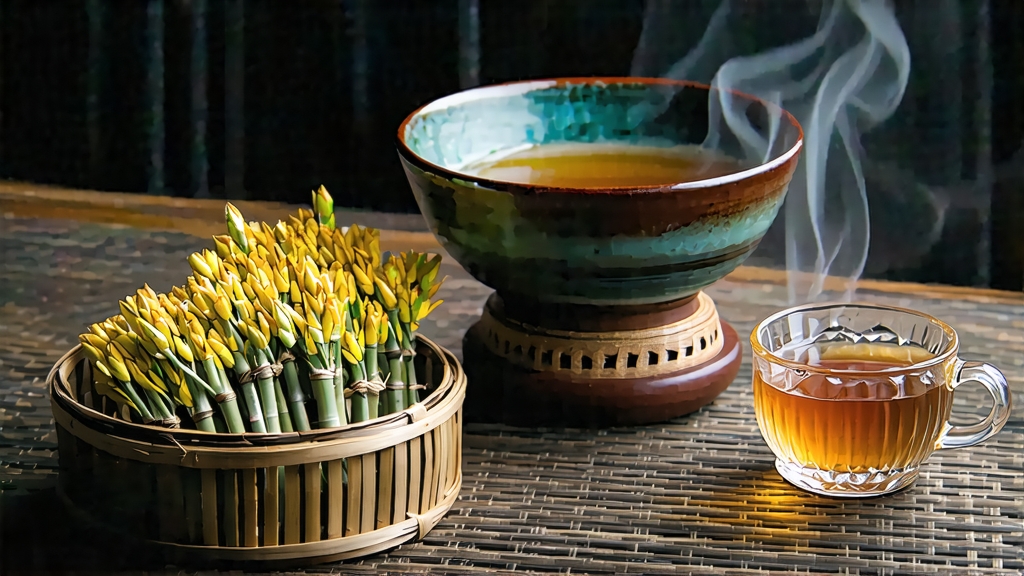
Among the six major chromatic families of Chinese tea, yellow tea is the rarest and most enigmatic; even within China, many drinkers pass their entire lives without encountering an authentic cup. Of the mere handful of yellow teas that survive, Huoshan Huangya—literally “Yellow Buds of Huoshan”—stands as the most venerable, once freighted on bamboo sedan chairs to the Forbidden City and now quietly guarded by a few hundred farming families clinging to the mist-veiled slopes of the Dabie Mountains in western Anhui Province. To taste it is to sip a fragment of Ming-dynasty court life, a liquor that carries the cool mineral breath of granite cliffs and the smoky memory of charcoal fires tended through the night.
History: From Imperial Tribute to Near Extinction
The first written record appears in the 1606 county gazetteer of Huoshan, noting that “the bud-yellow tea shall be presented to the throne each Qingming.” By the Kangxi era (1662-1722) the tea had become so coveted that county magistrates kept the location of the best gardens secret, sealing them with imperial wax during harvest season. Caravans left the mountains at dawn, the leaves packed in thin lead canisters to preserve their elusive fragrance on the 1,200-kilometre journey to Beijing. Yet fame proved fragile; the collapse of the Qing court in 1911 removed the guaranteed market, and the ensuing wars scattered the tea artisans. When the China Tea Corporation revisited Huoshan in 1972, only three elderly masters could still recall the full “menhuang” (sealed yellowing) protocol. A painstaking revival began with government seed stock and a single 300-year-old mother tree in Jinji Mountain; today, protected-origin status limits production to 280 hectares of defined elevation (300–800 m) and north-facing slopes.
Terroir: Where Granite Meets Cloud
Huoshan County lies at 31° N, the same latitude as the tea-famous Shizuoka Prefecture in Japan, but the similarity ends there. The Dabie range funnels moist air from the Yangtze floodplain upward, creating 220 fog-bound days per year. The soil is a coarse, acidic granite regolith, poor in nitrogen but rich in potassium and fluoride, forcing the tea bush (predominantly the small-leaf “Huoshan early bud” cultivar) to channel nutrients into fewer, more aromatic shoots. Temperature swings of 15 °C between day and night slow chlorophyll synthesis, allowing carotenoids and anthocyanins to tint the young leaves a pale jade edged in maroon—an essential chromatic precursor to the final golden hue.
Harvest Calendar: One Leaf, One Coin
Plucking begins around 20 March, when five consecutive days hold steady at 12–15 °C and the buds reach 15 mm without unfurling. Workers pinch the “single bud with one standing leaf” standard, a gesture that must be completed before 10 a.m. while dew still guards against mechanical bruising. A skilled picker gathers barely 400 g per hour; 50,000 such budsets shrink to 100 g of finished tea, explaining why imperial accountants once valued one liang (37 g) at the equivalent of a labourer’s monthly wage.
Craft: The Secret 48-Hour Suffocation
Yellow tea’s identity rests on the extra “menhuang” (sealed yellowing) step inserted between killing-green and shaping. Within two hours of plucking, the buds are spread on bamboo trays and withered for 30 minutes over a charcoal-less copper wok held at 65 °C; this “soft kill” deactivates roughly 70 % of polyphenol oxidase while preserving a faint enzymatic whisper. The leaves are then rolled for eight minutes under 4 kg of pressure, just enough to fracture cell walls without breaking the surface fuzz.
The critical moment follows: the bruised buds are piled 8 cm deep inside a cedar box lined with wet flax cloth, then slid into a sealed earthen chamber kept at 28 °C and 85 % relative humidity. For the next 36–48 hours the tea undergoes non-enzymatic browning: chlorophyll degrades into pheophytin, catechins dimerise into theaflavins, and a faint maillard note of toasted sesame emerges. Masters judge readiness by scent alone—when the green grassy